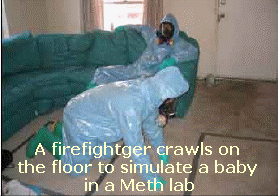|
While many people acknowledge the dangers of being in an area where Meth
is being manufactured, some might have questions about the lingering
dangers after the cooking is done. The National Jewish Medical and
Research Center set up a controlled study to test what chemicals would
still pose a hazard up to 24-hours following a cook. It was designed to
determine the primary chemical exposures associated with clandestine Meth
labs, how the chemicals spread through an area and how long they last. It
also looked at various activities, such as walking and vacuuming in the
Meth lab, to measure exposures that may result from re-suspension of
chemicals from contaminated surfaces.
The experiment took two days. The first involved manufacturing two
batches of Meth, each about three-grams worth, using the Red P method.
Each cook took approximately four hours.

On the second day,
researchers tested the residual chemical levels and Meth contamination
12-24 hours after the cook. Initial “no activity” samples were taken
approximately 13 hours after the 2nd cook to determine the concentrations
of chemicals prior to “medium” and “heavy” activities during the day.
Medium activities, such as walking through the home, sitting on the couch,
and opening/closing cabinet doors were performed 16 hours after the second
cook. At 18 hours, heavy activities, such as vacuuming, fluffing pillows,
and walking or crawling through the home were performed to evaluate a
“worst case” scenario of re-suspension of residual Methamphetamine.
The researchers
found:
• Detectable airborne concentrations of hydrochloric acid, iodine, and
Meth will remain within a structure for at least 24 hours.
• Normal household activities, such as walking and vacuuming can
re-suspend hydrochloric acid, iodine, and Meth from contaminated surfaces.
• Airborne Meth exposures on the day after a cook are similar to those
seen in remote areas of a house during a cook.
• The majority of airborne Meth is present as very small particles or as a
vapor. This indicates Meth – both during a cook or up to 24 hours after
one - penetrates deep into the lungs to the gas exchange region where it
is rapidly absorbed into the bloodstream.
You can find details of the study, its sampling methods and design, and
detailed results by visiting the
Center’s website.
|
|
You may also be interested in:
Meth Lab Overview
Contamination
Cleaning Methods
SD
Recommendations |
